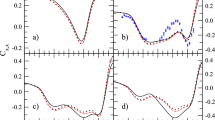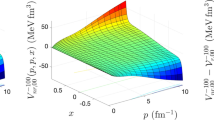Abstract
A recent calculation of the nuclear energy density functional from chiral two- and three-nucleon forces is extended to the isovector terms pertaining to different proton and neutron densities. An improved density-matrix expansion is adapted to the situation of small isospin asymmetries and used to calculate in the Hartree-Fock approximation the density-dependent strength functions associated with the isovector terms. The two-body interaction comprises of long-range multi-pion exchange contributions and a set of contact terms contributing up to fourth power in momenta. In addition, the leading-order chiral three-nucleon interaction is employed with its parameters fixed in computations of nuclear few-body systems. With this input one finds for the asymmetry energy of nuclear matter the value A(ρ 0) ≃ 26.5 MeV, compatible with existing semi-empirical determinations. The strength functions of the isovector surface and spin-orbit coupling terms come out much smaller than those of the analogous isoscalar coupling terms and in the relevant density range one finds agreement with phenomenological Skyrme forces. The specific isospin and density dependences arising from the chiral two- and three-nucleon interactions can be explored and tested in neutron-rich systems.
Similar content being viewed by others
References
M. Bender, P.H. Heenen, P.G. Reinhard, Rev. Mod. Phys. 75, 121 (2003).
J.R. Stone, P.G. Reinhard, Prog. Part. Nucl. Phys. 58, 587 (2007).
E. Chabanat, E. Bonche, P. Haensel, J. Meyer, P. Schaeffer, Nucl. Phys. A 635, 231 (1998).
N. Chamel, S. Goriely, J.M. Pearson, Nucl. Phys. A 812, 72 (2008).
B.D. Serot, J.D. Walecka, Int. J. Mod. Phys. E 6, 515 (1997).
T. Niksic, D. Vretenar, P. Ring, Prog. Part. Nucl. Phys. 66, 519 (2011).
S.K. Bogner, R.J. Furnstahl, A. Schwenk, Prog. Part. Nucl. Phys. 65, 94 (2010).
S.K. Bogner, T.T.S. Kuo, A. Schwenk, Phys. Rep. 386, 1 (2003).
J.W. Negele, D. Vautherin, Phys. Rev. C 5, 1472 (1972).
B. Gebremariam, T. Duguet, S.K. Bogner, Phys. Rev. C 82, 014305 (2010).
B. Gebremariam, S.K. Bogner, T. Duguet, Nucl. Phys. A 851, 17 (2011).
M. Stoitsov et al., Phys. Rev. C 82, 054307 (2010).
N. Kaiser, J.W. Holt, W. Weise, Eur. Phys. A 47, 128 (2011).
L. Coraggio et al., Phys. Rev. C 75, 024311 (2007).
S.K. Bogner, R.J. Furnstahl, A. Nogga, A. Schwenk, Nucl. Phys. A 763, 59 (2005).
A. Nogga, S.K. Bogner, A. Schwenk, Phys. Rev. C 70, 061002 (2004).
E. Epelbaum, W. Glöckle, Ulf-G. Meißner, Nucl. Phys. A 747, 362 (2005).
S.K. Bogner, R.J. Furnstahl, L. Platter, Eur. Phys. J. A 39, 219 (2009).
N. Kaiser, Eur. Phys. A 45, 61 (2010).
P.A. Seeger, W.M. Howard, Nucl. Phys. A 238, 491 (1975).
J.P. Blaizot, Phys. Rep. 64, 171 (1980).
D. Vretenar, T. Niksic, P. Ring, Phys. Rev. C 68, 024310 (2003).
K. Hebeler et al., Phys. Rev. C 83, 031301 (2011).
P.G. Reinhard, H. Flocard, Nucl. Phys. A 584, 467 (1995).
Author information
Authors and Affiliations
Corresponding author
Additional information
Communicated by M. Hjorth-Jensen
Rights and permissions
About this article
Cite this article
Kaiser, N. Isovector part of nuclear energy density functional from chiral two- and three-nucleon forces. Eur. Phys. J. A 48, 36 (2012). https://doi.org/10.1140/epja/i2012-12036-3
Received:
Accepted:
Published:
DOI: https://doi.org/10.1140/epja/i2012-12036-3




